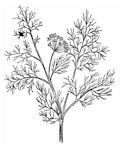Description
It has a thick, perennial root-stock, stout stems, 4 to 5 feet
or more in height, erect and cylindrical, bright green and so smooth as to seem
polished, much branched bearing leaves cut into the very finest of segments. The
bright golden flowers, produced in large, flat terminal umbels, with from
thirteen to twenty rays, are in bloom in July and August. The odor of Fennel
seed is fragrant, its taste, warm, sweet and agreeably aromatic.
Fennel is composed of a white or pale green bulb from which
closely superimposed stalks are arranged. The stalks are topped
with feathery green leaves near which flowers grow and produce
fennel seeds. The bulbs, stalks, leaves and seeds are all
edible. Fennel belongs to the Umbellifereae family and is
therefore closely related to parsley, carrots, dill and
coriander.
Culture
Fennel will thrive anywhere, and a plantation will last for years. It
is easily propagated by seeds, sown early in April in ordinary soil. It likes
plenty of sun and is adapted to dry and sunny situations, not needing heavily
manured ground, though it will yield more on rich stiff soil.
There are several varieties of Fennel fruit
known as Roman Fennel, German or Saxon Fennel, wild or bitter
Fennel, Galician Russian and Roumanian Fennel, Indian, Persian
and Japanese. The fruits vary very much in length, breadth,
taste and other characters, and are of very different commercial
value.
Use
Fennel seed is used in the food and flavor industry for addition
to meats, vegetable products, fish sauces, soups, salad dressings, stews,
breads, pastries, teas, and alcoholic beverages. Crushed seed has been used as a
substitute for juniper in flavoring gin. The essential oil and the oleoresin of
fennel are used in condiments, soaps, creams, perfumes, and liqueurs. Several
types of fennel differing in morphology and leaf color are available for
ornamental use and as a fresh vegetable.
Toasting Fennel Seeds accentuates their
flavor. Fennel Seed added to meatballs or meat loaf gives an
authentic Italian flavor. Saute Fennel Seed with sliced peppers,
onion, and sausage for a quick pasta sauce.
Folklore
In mediaeval times, Fennel was employed,
together with St. John's Wort and other herbs, as a preventative
of witchcraft and other evil influences, being hung over doors
on Midsummer's Eve to warn off evil spirits. It was likewise
eaten as a condiment to the salt fish so much consumed by our
forefathers during Lent. Like several other umbelliferae, it is
carminative.
Culinary Oils and Vinegars


